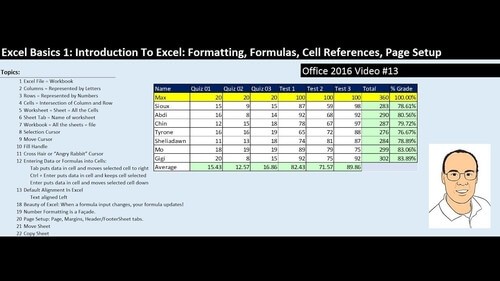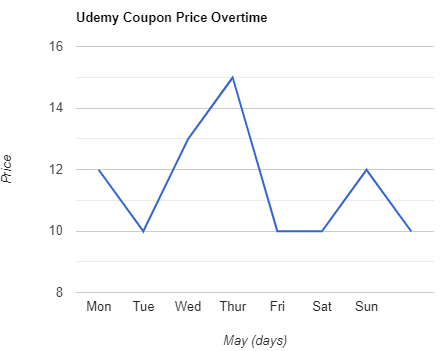Analyzing and Visualizing Data with Excel
EdX designed this course to teach Excel from a perspective of visualizing data. While it covers the basics of inputting and manipulating data, it emphasizes visual representations and presentations. It takes a data-science approach to using Excel and is offered through a six-week curriculum.
Created by: Dany Hoter
Produced in 2016
 What you will learn
What you will learn
- How to gather and use data from more than one source.
- Combining and discovering data with mashups.
- Data modeling and model creation.
- Exploring, visualizing and analyzing data.
 Quality Score
Quality Score
Content Quality
/
Video Quality
/
Qualified Instructor
/
Course Pace
/
Course Depth & Coverage
/
Overall Score : 86 / 100
 Live Chat with CourseDuck's Co-Founder for Help
Live Chat with CourseDuck's Co-Founder for Help
Need help deciding on a excel course? Or looking for more detail on Dany Hoter's Analyzing and Visualizing Data with Excel? Feel free to chat below.
Join CourseDuck's Online Learning Discord Community
 Course Description
Course Description
Excel is one of the most widely used solutions for analyzing and visualizing data. It now includes tools that enable the analysis of more data, with improved visualizations and more sophisticated business logics. In this data science course, you will get an introduction to the latest versions of these new tools in Excel 2016 from an expert on the Excel Product Team at Microsoft.
Learn how to import data from different sources, create mashups between data sources, and prepare data for analysis. After preparing the data, find out how business calculations can be expressed using the DAX calculation engine. See how the data can be visualized and shared to the Power BI cloud service, after which it can be used in dashboards, queried using plain English sentences, and even consumed on mobile devices.
Do you feel that the contents of this course is a bit too advanced for you and you need to fill some gaps in your Excel knowledge? Do you need a better understanding of how pivot tables, pivot charts and slicers work together, and help in creating dashboards? If so, check out DAT205x: Introduction to Data Analysis using Excel.
edX offers financial assistance for learners who want to earn Verified Certificates but who may not be able to pay the fee. To apply for financial assistance, enroll in the course, then follow this link to complete an application for assistance.
Week 1
Setup the lab environment by installing Office applications. Learn how to perform data analysis in Excel using classic tools, such as pivot tables, pivot charts, and slicers, on data that is already in a worksheet / grid data. Explore an Excel data model, its content, and its structure, using the Power Pivot add-in. Create your first DAX expressions for calculated columns and measures.
Week 2
Learn about queries (Power Query add-in in Excel 2013 and Excel 2010), and build an Excel data model from a single flat table. Learn how to import multiple tables from a SQL database, and create an Excel data model from the imported data. Create a mash-up between data from text-files and data from a SQL database.
Week 3
Get the details on how to create measures to calculate for each cell, filter context for calculation, and explore several advanced DAX functions. Find out how to use advanced text query to import data from a formatted Excel report. Perform queries beyond the standard user interface.
Week 4
Explore ways to create stunning visualizations in Excel. Use the cube functions to perform year-over-year comparisons. Create timelines, hierarchies, and slicers to enhance your visualizations. Learn how Excel can work together with Power BI. Upload an Excel workbook to the Power BI service. Explore the use of Excel on the mobile platform.
Learn how to import data from different sources, create mashups between data sources, and prepare data for analysis. After preparing the data, find out how business calculations can be expressed using the DAX calculation engine. See how the data can be visualized and shared to the Power BI cloud service, after which it can be used in dashboards, queried using plain English sentences, and even consumed on mobile devices.
Do you feel that the contents of this course is a bit too advanced for you and you need to fill some gaps in your Excel knowledge? Do you need a better understanding of how pivot tables, pivot charts and slicers work together, and help in creating dashboards? If so, check out DAT205x: Introduction to Data Analysis using Excel.
edX offers financial assistance for learners who want to earn Verified Certificates but who may not be able to pay the fee. To apply for financial assistance, enroll in the course, then follow this link to complete an application for assistance.
Week 1
Setup the lab environment by installing Office applications. Learn how to perform data analysis in Excel using classic tools, such as pivot tables, pivot charts, and slicers, on data that is already in a worksheet / grid data. Explore an Excel data model, its content, and its structure, using the Power Pivot add-in. Create your first DAX expressions for calculated columns and measures.
Week 2
Learn about queries (Power Query add-in in Excel 2013 and Excel 2010), and build an Excel data model from a single flat table. Learn how to import multiple tables from a SQL database, and create an Excel data model from the imported data. Create a mash-up between data from text-files and data from a SQL database.
Week 3
Get the details on how to create measures to calculate for each cell, filter context for calculation, and explore several advanced DAX functions. Find out how to use advanced text query to import data from a formatted Excel report. Perform queries beyond the standard user interface.
Week 4
Explore ways to create stunning visualizations in Excel. Use the cube functions to perform year-over-year comparisons. Create timelines, hierarchies, and slicers to enhance your visualizations. Learn how Excel can work together with Power BI. Upload an Excel workbook to the Power BI service. Explore the use of Excel on the mobile platform.
 Pros
Pros
 Cons
Cons
-
- Course is part of multiple Microsoft certification series, including Excel Fundamentals, Microsoft Data Science, Data Analysis and Microsoft Excel for the Data Analyst.
- Course was developed by Microsoft itself, and it includes a Microsoft certification upon completion.
- Totaling 18 hours, the course covers topics of data management thoroughly.
-
- The course only supports Excel 2019, 2013 and 2016. While users of newer versions can still benefit from the course, they may run into frustrations where inputs and applications diverge from the supported versions.
- While the course is free, the certification is not.
 Instructor Details
Instructor Details

- 4.3 Rating
 11 Reviews
11 Reviews
Dany Hoter
Dany Hoter is a solutions architect with DataRails, a startup company that adds enterprise abilities to Excel. He has been involved with business intelligence (BI), Excel, and BI in Excel since 1998. Previously, he worked for Microsoft as a Program Manager in the Excel team. Dany is very passionate about educating Excel users and is happy to connect on LinkedIn.
 Students also recommend
Students also recommend

-
Microsoft Excel - Online Tutorial for Beginners (2010)
-
0.0 (0 Reviews)
-
 Provider: Chandoo.org
Provider: Chandoo.org Time: 1h 30m
Time: 1h 30m
Free






